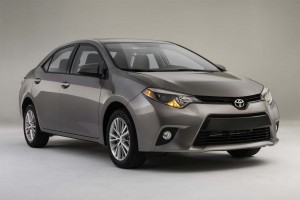Toyota has kept the global sales crown firmly planted on its corporate head – at least for now.
The Japanese giant managed to deliver 10.151 million vehicles in 2015, giving it the lead for the fourth year in a row, ahead of Volkswagen AG which, in turn, narrowly nudged past General Motors. But things might get a little tougher for Toyota in 2016, President Akio Toyoda forecasting a slight decline in sales over the course of this year.
Perhaps the biggest question is how well Volkswagen will fare as it struggles to recover from a diesel emissions scandal that has seen its sales slip around the world in recent months. The German maker is currently unable to sell the diesel models that make up a quarter of its volume in the U.S. market.
Toyota, meanwhile, could be setting in play several steps meant to expand its global presence, particularly in the lower ends of the automotive spectrum, and in the fast-growing Indian market. According to various reports out of Japan.
(Toyota Corolla sets new record — and remains world’s best-selling nameplate in 2015. Click Here for that story.)
Toyota may invest about $3 billion to buy out the rest of Daihatsu. It already holds a 51.2% stake in the minicar maker which is particularly strong in the so-called Kei Car segment. That is the only market niche to see any real growth in the Japanese home market in recent years.
Meanwhile, Toyota is said to be discussing possible cooperation with Japan’s Suzuki, which also focuses on the lower segments of the industry. Suzuki is the biggest foreign player in the booming Indian market where Toyota has struggled for a foothold.
Toyota could use a bump. Though it remained the global sales leader in 2015, its sales slipped from the 10.23 million vehicles reported for 2014. Part of the problem has been the weak Japanese market, but Toyota has not done nearly as well as it had hoped in China. On the plus side, it continued to grow demand in its largest single market, North America.
And that was enough to beat back a challenge by Volkswagen, the German company briefly holding the global sales lead during the first half of 2015. But its sales have been hammered by a crisis spurred by its admitted cheating on diesel emissions standards. VW acknowledged rigging software capable of detecting when a vehicle equipped with its 2.0-liter turbodiesel engine was undergoing emissions tests.
(Click Here for details about FCA earnings sliding 40%.)
The company was set to begin this month repairing most of the 11 million vehicles sold worldwide equipped with the so-called defeat device. But it has yet to reach an agreement with regulators in the U.S. to fix 482,000 of those vehicles sold in the States. And that means it still can’t sell new diesel products in the market.
VW fell just 90,000 vehicles short of Toyota in 2014, at 10.14 million. But that figure slipped to 9.93 million last year.
VW still managed to keep rival General Motors at bay. The Detroit maker managed to boost global sales by 21,000 last year, to 9.8 million.
GM was the world’s auto sales leader for three-quarters of a century, but it lost the lead as it plunged towards a 2009 bankruptcy. It briefly snatched the crown back in 2011, Japanese car production hammered by that country’s devastating earthquake and tsunami.
(To see more about the new automotive safety consortium, Click Here.)
Toyota was back in the lead a year later, though it has had to keep looking over its shoulder. The race could tighten in 2016 with the industry leader forecasting sales will again dip to 10.114 million.


I’m tired of people talking about the tsunami and earthquake as Toyotas fall from grace. It was the sudden acceleration the crappy gas peddle set up they first tried to blame on floor matts that took them down.
Jeffyoungken-
FYI – NO ONE ever proved Unintended Acceleration EVER existed in ANY modern vehicle be it the Audi 5000’s, Toyotas or any other model. You appear to be confusing driver error and floor mats kicked under the accelerator pedal for unintended acceleration. They are NOT the same thing.
NHTSA, Toyota, NASA and other independent agencies investigated the Toyota vehicles and declared that NO documented unintended acceleration existed and NO ONE has been able to make these vehicles achieve unintended acceleration. In fact the investigators made it very clear that the black boxes that record driver inputs and vehicle actions showed drivers who claimed they were pushing on the brake pedal, were actually pushing on the accelerator pedal.
It’s disgraceful that the media sensationalizes these stories to the point that many folks actually believe the false claims by vehicle operators and the disingenuous reporting by some in the media to promote their beliefs or agendas. Reporting the truth isn’t any where near as sensational as the bogus claims of people looking to cash in for their incompetence. Few in the media correct their false claims as they are too busy finding the next story they can profit from…
Exactly!..
Please consider converting the numbers embedded in the prose into a table in the future. The prose still works but a table is much easier to understand.
Thanks,
Bob Wilson